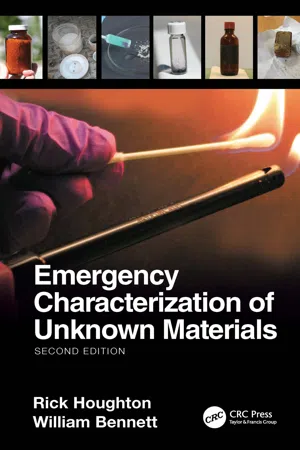
- 370 pages
- English
- ePUB (mobile friendly)
- Available on iOS & Android
Emergency Characterization of Unknown Materials
About This Book
Emergency Characterization of Unknown Materials, Second Edition is fully updated to serve as a portable reference that can be used in the field and laboratory by workers who are responsible for a safe response to and management of unknown hazardous materials. As with the first edition, the book emphasizes public safety and the management of life safety hazards, including strategies and emerging technologies to identify the hazards presented by an unknown material.
When responding to a hazardous material emergency involving an unknown substance, firefighters and HAZMAT teams are primarily interested in protecting public safety. The book details risk analysis procedures to identify threats and vulnerabilities, analyzing them to determine how such risks can be eliminated or reduced. If an unknown material can be identified with a high degree of confidence, that can considerably change the response, and measures to be taken.
In addition, the book covers practical field applications with updated and additional examples of field instruments. The hazard identification methods presented are intended for use by frontline workers. The test methods presented involve manipulation of small sample amounts – using, literally, a hands-on approach. The three technologies used by first responders and military personnel to identify unknown chemicals, Raman spectroscopy, FTIR spectroscopy and high-pressure mass spectroscopy, are covered in depth.
Features
-
- Presents how to identify unknown materials and, if identification is not possible, to characterize the hazards of the material
-
- Offers practical examples to introduce new first responders to hazardous materials response
-
- Provides up-to-date field applications of the latest developments in commercially available instrumentation
-
- Details practical sample manipulations to help the reader successfully identify materials with popular high-end instrumentation
-
- Includes several examples of spectra and describes ways in which the reader can utilize data to inform decision making
New coverage to this edition includes a chapter and content that focuses on sample manipulation and separations using instruments developed and revised since the first edition was published. These sample manipulations may be performed in the field with a very simple toolkit, which is fully outlined and explained in detail. Identifying the hazards of the unknown substance is essential to plan for response, contingencies and sustained actions. As such, Emergency Characterization of Unknown Materials, Second Edition will be a welcome and essential resource to all response and safety professionals concerned with hazardous materials.
Frequently asked questions
Information
1
Terms and Definitions

Corrosive (acids and bases/alkaline) Air reactivity Auto refrigeration Biological agents and biological toxins Blood agents Boiling point Catalyst Chemical change Chemical interactions Compound, mixture Concentration Critical temperature and pressure Dissociation (acid/base) Dose Dose response Expansion ratio Fire point Flammable (explosive) range (LEL and UEL) Flashpoint Half-life Halogenated hydrocarbon Ignition (auto ignition) temperature Inhibitor Instability Ionic and covalent compounds Irritants (riot control agents) Maximum safe storage temperature (MSST) Melting point and freezing point Miscibility Nerve agents Organic and inorganic Oxidation potential Persistence pH Physical change Physical state (solid, liquid, gas) Polymerization Radioactivity Reactivity Riot control agents Saturated, unsaturated (straight and branched), and aromatic hydrocarbons Self-accelerating decomposition temperature (SADT) Solubility Solution and slurry Specific gravity Strength Sublimation Temperature of product Toxic products of combustion Vapor density Vapor pressure Vesicants (blister agents) Viscosity Volatility |
Physical Terms and Definitions
Physical State
Table of contents
- Cover
- Half-Title
- Title
- Copyright
- Contents
- Acknowledgments
- Authors
- Introduction
- 1 Terms and Definitions
- 2 Hazards
- 3 Detection Technology
- 4 Strategies
- 5 Techniques
- Index